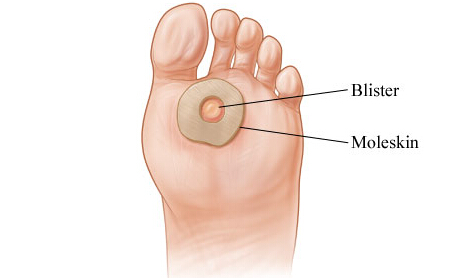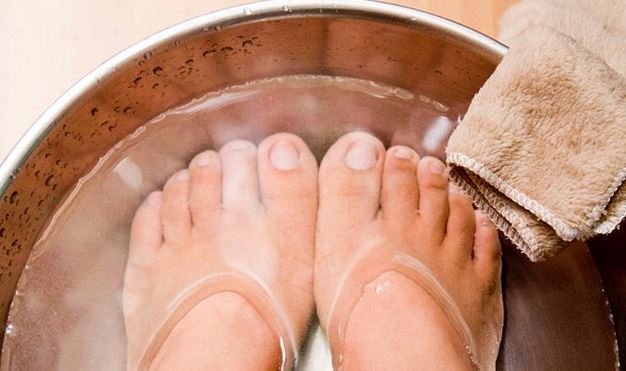Blisters refer to small sacs over the superficial surface of skin that are filled with thin, clear (or turbid) fluid. The most common site of occurrence is the foot, especially when a person wears new shoes orworking in the garden without wearing protective cover or gloves). Since blisters are formed over the surface of skin, it is usually pretty easy to identify these lesions in initial stages. Appropriate treatment can hasten the recovery of blisters on bottom of feet, including home remedies and over-the-counter topical agents.
Potential Risks of Infections
Blisters are superficial in origin; but these lesions should not be ignored because if not treated in time, they can cause serious bacterial infections and may culminate in complications.
If left untreated, these superficial blisters often getfilled with pus, thereby forming an exudative condition, causing pain and discomfort. When they rupture, there is a potential risk of developing secondary impetigo or cellulitis, with are both bacterial infections. Leaving a blister untreated also aggravates the risk of developing sepsis, in which the infectious agents penetrates into the blood or body tissues, causing a life-threatening condition. Patients suffering from diabetes and hypertension are at a higher risk of developing blisters on bottom of feet, hence should be extra careful when dealing with this condition to avoid infection.
How to Deal with Blister on Bottom of Feet
With proper care and optimal hygiene, even bloody blisters can usually heal on their own. However, medications and home remedies can be used to decrease the pain, swelling and burning sensations over feet and associated tissues.
Bandage or Pad
A loose bandage can be applied over an unbroken blister to protect it from getting damaged.
Moleskin Pad

For blisters on bottom of feet or other weight bearing areas, a moleskin pad can be used. It’s shaped like a doughnut so you can leave the area over the blister open.
Draining the Blister
It is recommended not to drain blisters at home, but when the condition becomes painful, you may prefer to remove the fluid. In such cases, the following steps must be followed:
- Properly rinse your hands using good quality soap and lukewarm water.
- Apply iodine on a swab and clean the blister area with it.
- The needle which is to be inserted into blister should be thoroughly cleaned and sterilized with alcohol or other antiseptic agents.
- Puncture the blister using sterilized needle. Don’t pinch in the center of blister; instead aim for the edges. Once the needle is inserted, allow the fluid from the blister to drain, but do not remove the overlying skin.
- Once you drain the fluid, use an antibacterial ointment such as Vaseline and apply gently over the blister. Then cover it with gauze.
- Be sure to change the dressing every day, until the blister heals completely.
DO NOT drain the blisterif:
- You have diabetes, hypertension, cardiovascular diseases, cancer or are at-risk of developing HIV;
- The blister is caused by a contagious disease such as chicken pox.
Remedies for Blisters on Bottom of Feet
Alternatively, you can try a number of home remedies to relive the discomfort:
- Aloe Vera gel

Aloe Vera gel can be applied over the affected area as it possesses great astringent properties. This property helps in preventing the infection to spread, while also providing a cooling sensation.
- Soaking the feet in Epsom salt

Soaking the feet in lukewarm water mixed with Epsom salt is effective in relaxing the feet muscles. Apart from keeping the blister clean, it also makes the skin around the blister softer and accelerates the healing process. Soaking the feet is especially relaxing after walking in uncomfortable footwear.
- Apple cider vinegar

Apple cider vinegar possesses anti-bacterial properties, which helps is preventing the development of infections. Take a cotton swab, dip it in the vinegar and rub the swab around the popped blister. It may sting a bit.
Preventing Blisters on Bottom of Feet
- Wear proper socks
The key to blister prevention revolves around protecting the feet from getting damaged by ill-fitting or tight footwear. A pair of comfortable and clean socks can keep the feet away from moisture and also minimize the risk of developing blisters due to friction.
It is recommended to wear socks which are made of breathable fiber and are not irritative to the skin, such as nylon or wicking. Wearing double socks is also a good idea to prevent friction.
- Protective bandages and tapes
Different variety of tapes and bandages such as moleskin pads are available on the market, which can be applied over problematic areas where blisters often form. These bandages must be used before putting on socks. Read the instructions on the package and follow them closely.
- Use powders and creams
Foot powders are available in over-the-counter formulations. These agents can be sprinkled on to the socks to reduce friction. Alternatively, you can also use emollient creams such as Vaseline to make a protective covering, thereby preventing the formation of blisters on bottom of feet.
- Comfortable shoes
Wearing comfortable and well-fitted shoes helps in reducing the incidence of foot blisters. Running stores can help in determining if you are wearing the best fit or not. If all preventive measures have failed, specialists can also perform a gait analysis to better determine the cause of blisters.
